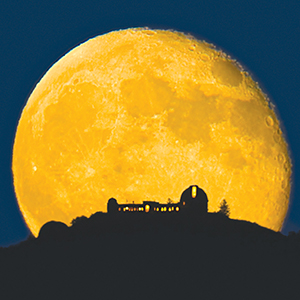Features & Columns
The Tara Project Grants
Global Access to Lick Observatory
hopes of making the world 'smaller.'
 TARA NOVA: The Tara Project connects people to the great beyond in hopes of making the world 'smaller.' Photograph by Laurie Hatch
TARA NOVA: The Tara Project connects people to the great beyond in hopes of making the world 'smaller.' Photograph by Laurie Hatch Like a central station connecting a vast network of interrelated trajectories, Lick Observatory has returned to the forefront. The Tara Project connects Lick to Blackrock Castle Observatory near Cork, Ireland. Another project connects artist Russell Crotty to the San Jose Institute of Contemporary Art (SJICA), via Lick Observatory.
In both cases, Lick functions like a jewel in Indra's net, reflecting every jewel, all at the same time.
The Tara Project comes to us from several directions. San Francisco is a sister city with Cork, Ireland, and San Jose is a sister city with Dublin. Lick is owned and operated by the University of California, which means the project is facilitated by the Multiverse Education Group at UC Berkeley's Space Science Lab, along with Blackrock Conservatory. Both institutions hope to leverage the eight-hour time difference by placing telescopes in California schools and having Irish students remotely operate the telescopes from their classrooms.
For example, the California students can study solar science via the telescope during their regular daytime school hours, and the Irish students, being eight hours ahead, can remotely operate the California telescope, when it's nighttime here, to make their respective nighttime observations. This eliminates the issue of continuous cloudy skies over Ireland.
"Astronomy is well known to be a gateway science," explains Claire Raftery, an Irish solar physicist in Berkeley heavily involved with the project. "It's a way that kids can get involved in science, almost surreptitiously. They can get involved in it when they're doing astronomy, and they can get good at it, and then move on and build their confidence with other, more complex, less accessible sciences. So it's a great way of getting kids invested from the very beginning."
As a result, kids not only learn how to do science at a young age, but they develop cross-cultural communication skills by collaborating with kids from another country. It's not just about taking pictures with a telescope. Future implementations might even include entire class-to-class projects between California schools and Irish students to identify objects in the sky or even develop future science projects, with potential for grooming future international diplomats in the process.
The partnering institutions are still looking for funds to make every level of the project happen over the course of the next few years. The goal is to prioritize rural schools that don't normally have access to full-blown science centers, libraries or massive amounts of public outreach. One such telescope is already installed at Ormondale Elementary School in Portola Valley. The gears are turning and ultimately the project will extend by next year to Lick Observatory. Kids in Ireland should be able to remotely operate the nickel telescope at Lick, all in the name of international STEM education.
All in all, it's a fantastic idea. Never before has Lick Observatory been open to remote operation by anyone outside the UC system, let alone an institution outside the U.S. Ireland's Minister for the Diaspora, Jimmy Deenihan, even stopped by Lick last year when he was minister for the arts. It was reported that visiting Lick was the highlight of his trip.
"It's all about just helping to make the world smaller," Raftery said. "The message we want to bring is, 'We're all one world under one sky.'"
That world would be a much better one if STEM included an "A" for the arts, so it only makes sense that Lick Observatory also currently functions as the nucleus for another landmark collaboration.
SJICA recently received a grant from the Warhol Foundation to help support artist Russell Crotty's residency, developed in partnership with the Institute of the Arts and Sciences at UC-Santa Cruz. Crotty is a nationally recognized artist, a 2015 Guggenheim Fellow and an amateur astronomer who has created astronomy-based artworks for nearly two decades. He's been trekking up to Mount Hamilton to use Lick telescopes for direct observations and photographs, as well as poring through the observatory archives, all to serve as the basis for a new show premiering at SJICA one year from now.


